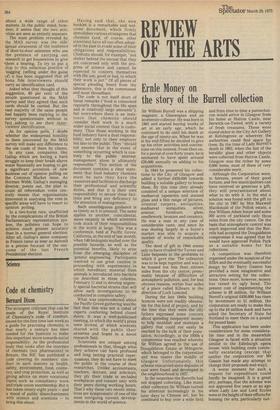Science
Code cot chemistry
Bernard Dixon
The strongest Criticism that can be made of the Royal Institute of Chemistry's cede of conduct. issued for the first time last week as a guide for practising chemists, is that nearly a century has been needed for the Institute to make this important move towards social responsibility. As the professional body that looks after the interests of chemists (not pharmacists) in Britain, the RIC has published a code covering its members' conduct in such matters as health, safety, environment, food, cosmetics, and crop protection, as well as giving advice on more vocational topics such as consultancy work and trade union membership. But it has taken ninety-eight years — and a mood of public disenchantment with science and scientists — to bring this about. Having said that, the new booklet is a remarkable and welcome document, which firmly demolishes various stratagems that chemists (and, of course, other scientists) have all too often adopted in the past to evade some of their obligations and responsibilities. Chemists should, for example, "not shelter behind the excuse that they are concerned only with the progress of science and cannot be expected to concern themselves with the use, good or bad, to which their work is put." Of all pieces of special pleading heard from the laboratory, this is the commonest and most threadbare.
The code is not itself short of banal remarks ("food is consumed regularly throughout the life span and in relatively large amounts"), but everywhere there is an insistence that chemists should consider their work in a much wider social context than is customary. Thus those working in the food industry have a dual responsibility, not only to their employer but also to the public. They "should not assume that in the event of something occurring which is contrary to the public interest management alone is ultimately responsible." This section of the document contains a clear statement that food industry chemists must be sure they have the resources and facilities to dischargetheir professional and scientific duties, and that it is their own responsibility to secure these facilities and bring any deficiency to the attention of management.
Such unambiguous guidance is as timely as it is unusual. The same applies to another, coincidental, move recently in which scientists took stock of their responsibilitiesin the world at large. This was a conference, held at Pacific Grove, California, at the end of last month, when 140 biologists mulled over the possible hazards, as well as the 'potential benefits, likely to arise from the emerging discipline or 'genetic engineering.' Participants resolved to use great caution in proceeding with experiments in which hereditary material from animals is introduced into bacteria (as described in these columns, February 1) and to develop urgently special bacterial strains that will allow such investigations to be conducted in complete safety.
What was unprecedented about the Pacific Grove gathering was the fact that this was not a cabal of experts conferring behind closed doors. It was a well-publicised meeting, to which the world's press were invited, at which scientists shared with the public their anxieties and hopes in a novel research field.
Scientists are unique among professionals in that, though what they achieve can have profound and long lasting practical repercussions, they do not have to meet the public in the course of their researches. Unlike accountants, teachers, doctors, and solicitors, they ply their trade in secluded workplaces and consort only with their peers during working hours. That's why these two recent initiatives are symptomatic of one of the most intriguing current developments in the world of science.


































 Previous page
Previous page